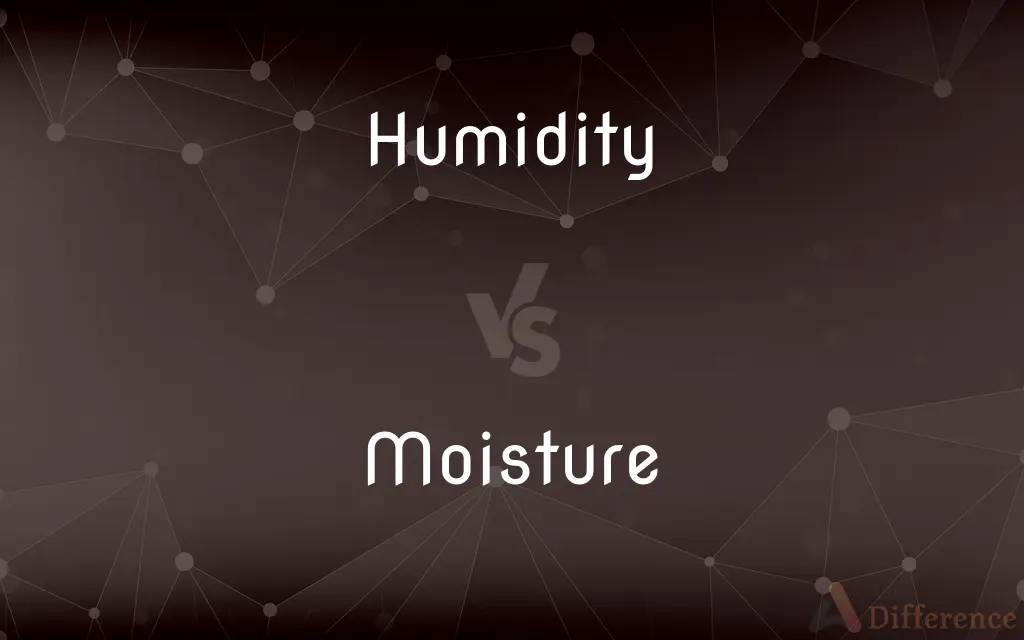Humidity vs. Moisture — What's the Difference?
Edited by Tayyaba Rehman — By Fiza Rafique — Updated on October 27, 2023
Humidity refers to the amount of water vapor in the air, while Moisture is the presence of liquid, often water, in a substance or surface.

Difference Between Humidity and Moisture
Table of Contents
ADVERTISEMENT
Key Differences
Humidity is a term commonly associated with meteorology and climatology. It describes the concentration of water vapor present in the atmosphere. Conversely, Moisture is a more general term that denotes the presence of liquid, especially water, in a material or environment.
In everyday language, when people discuss feeling "humid," they're referring to the sensation of heavy or damp air due to a high concentration of water vapor. On the other hand, when they mention something has "moisture," it implies that the object or substance is wet or damp, often due to the presence of liquid water.
It's crucial to recognize that Humidity is typically measured as a percentage, indicating the amount of water vapor the air holds relative to the maximum it can at a specific temperature. In contrast, Moisture doesn't always have a standardized measurement and can be perceived through touch or seen as wetness or dampness on a surface.
The effects of high Humidity are often felt on the human body as stickiness or sweatiness since the body's perspiration doesn't evaporate as efficiently in humid conditions. Moisture, on the other hand, can be evident in many scenarios, like dew on grass, dampness on a towel, or wetness in soil.
Humidity plays a pivotal role in weather patterns and can influence temperature perceptions and comfort levels. Meanwhile, Moisture can impact materials' physical properties, from making paper soggy to causing metal to rust or wood to rot.
ADVERTISEMENT
Comparison Chart
Definition
Amount of water vapor in the air.
Presence of liquid in a substance or surface.
Common Association
Meteorology and climatology.
Wetness or dampness in materials.
Measurement
Typically measured as a percentage.
Often perceived by touch or appearance.
Sensation
Felt as stickiness or dampness in the air.
Felt or seen as wetness on a surface.
Impact
Influences weather and comfort levels.
Affects physical properties of materials.
Compare with Definitions
Humidity
The concentration of water vapor in the atmosphere.
The high humidity made the day feel hotter than it was.
Moisture
The presence of liquid, especially water, in a substance.
The soil's moisture content is perfect for planting.
Humidity
The amount of water vapor the air contains.
Air conditioners help reduce indoor humidity.
Moisture
Liquid diffused or condensed in substances.
The bread lost its crispness due to moisture.
Humidity
A factor influencing perceived temperatures.
Despite the cool temperature, the humidity made it feel muggy.
Moisture
A factor causing changes in material properties.
Moisture caused the metal to rust.
Humidity
A measure of the dampness in the air.
The humidity level reached 90% today.
Moisture
Liquid content within an environment or material.
Seal the package to keep out moisture.
Humidity
A determinant in weather patterns and conditions.
The rise in humidity often precedes rainfall.
Moisture
Wetness or dampness on a surface or material.
The morning moisture settled on the leaves.
Humidity
Humidity is the concentration of water vapour present in the air. Water vapor, the gaseous state of water, is generally invisible to the human eye.
Moisture
Moisture is the presence of a liquid, especially water, often in trace amounts. Small amounts of water may be found, for example, in the air (humidity), in foods, and in some commercial products.
Humidity
Dampness, especially of the air.
Moisture
Diffuse wetness that can be felt as vapor in the atmosphere or condensed liquid on the surfaces of objects; dampness.
Humidity
Relative humidity.
Moisture
That which moistens or makes damp or wet; exuding fluid; liquid in small quantity.
Drops / beads of moisture
Humidity
Dampness, especially that of the air.
Moisture
The state of being moist.
Humidity
The amount of water vapour in the air.
Moisture
(medicine) Skin moisture noted as dry, moist, clammy, or diaphoretic as part of the skin signs assessment.
Humidity
Moisture; dampness; a moderate degree of wetness, which is perceptible to the eye or touch; - used especially of the atmosphere, or of anything which has absorbed moisture from the atmosphere, as clothing.
Moisture
A moderate degree of wetness.
Humidity
The content of water vapor in the air, expressed as a percent of the maximum amount of water vapor that the air can hold at the given temperature; also called relative humidity. The capacity of the air to hold moisture increases with temperature, so if the temperature changes without changing the absolute content of the atmospheric moisture, the relative humidity will also change.
Moisture
That which moistens or makes damp or wet; exuding fluid; liquid in small quantity.
All my body's moistureScarce serves to quench my furnace-burning heat.
Humidity
Wetness in the atmosphere
Moisture
Wetness caused by water;
Drops of wet gleamed on the window
Common Curiosities
What does Humidity measure?
Humidity measures the amount of water vapor in the air.
How is Moisture different from Humidity?
Moisture refers to the presence of liquid in a substance or surface, while Humidity is about water vapor in the air.
Why do we feel sticky on highly humid days?
High Humidity hinders the evaporation of sweat from the skin, leading to a sticky feeling.
Is Moisture visible?
Sometimes. Moisture can be seen as wetness or dampness on surfaces but might be invisible when diffused in materials.
Is a humid day always a rainy day?
Not necessarily. While high Humidity can precede rainfall, it doesn't guarantee rain.
Is there a device to measure Humidity?
Yes, a hygrometer is a device used to measure Humidity.
Can Humidity affect how hot or cold we feel?
Yes, high Humidity can make temperatures feel hotter, and low Humidity can make it feel cooler.
Is Moisture always related to water?
Typically, Moisture refers to the presence of water, but it can be about other liquids in different contexts.
How is Humidity commonly measured?
Humidity is typically measured as a percentage of how much water vapor the air holds relative to the maximum it can at a certain temperature.
Can Moisture impact the condition of materials?
Yes, Moisture can affect materials, causing things like rust in metal or rot in wood.
What might cause increased Moisture in a room?
Leaks, poor ventilation, or activities like cooking and showering can increase Moisture in a room.
Why is Moisture often a concern for stored goods?
Moisture can cause damage, mold growth, or degradation in many stored goods.
Why might someone use a dehumidifier?
A dehumidifier is used to reduce Humidity levels in indoor spaces, improving comfort and preventing mold growth or other moisture-related issues.
Can Moisture be present in the air?
Yes, when Moisture is present in the air as water vapor, it contributes to the air's Humidity.
Can low Humidity have effects on health or comfort?
Yes, low Humidity can cause dry skin, respiratory issues, and discomfort.
Share Your Discovery

Previous Comparison
Haiku vs. Tanka
Next Comparison
Impressionism vs. ExpressionismAuthor Spotlight
Written by
Fiza RafiqueFiza Rafique is a skilled content writer at AskDifference.com, where she meticulously refines and enhances written pieces. Drawing from her vast editorial expertise, Fiza ensures clarity, accuracy, and precision in every article. Passionate about language, she continually seeks to elevate the quality of content for readers worldwide.
Edited by
Tayyaba RehmanTayyaba Rehman is a distinguished writer, currently serving as a primary contributor to askdifference.com. As a researcher in semantics and etymology, Tayyaba's passion for the complexity of languages and their distinctions has found a perfect home on the platform. Tayyaba delves into the intricacies of language, distinguishing between commonly confused words and phrases, thereby providing clarity for readers worldwide.
















































